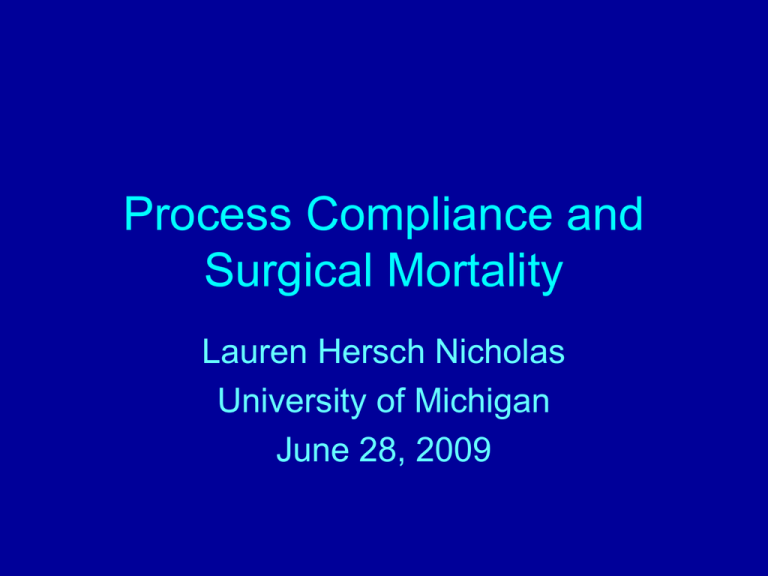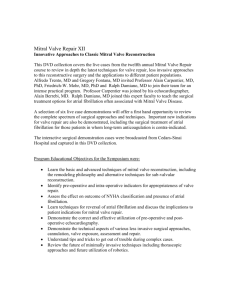Process Compliance and Surgical Mortality Lauren Hersch Nicholas University of Michigan
advertisement

Process Compliance and Surgical Mortality Lauren Hersch Nicholas University of Michigan June 28, 2009 Background • Poor overall quality and variation in surgical quality across U.S. hospitals welldocumented • As large public payer, Medicare can influence quality for all patients • Public reporting of quality measures and performance pay are thought to be ways to achieve this goal Hospital Quality Initiative • Hospital Quality Alliance, voluntary publicprivate collaboration formed to support public reporting of hospital quality (process measures) • Hospital Compare website starts collecting and reporting performance: voluntary reporting starts October 2003 • 2003 Medicare Modernization Act requires hospitals to report to HC to receive full market update in reimbursement Hospital Compare Surgical Quality Measures • Infection Prevention – Prophylactic antibiotic receipt within one hour of surgery – Prophylactic antibiotic discontinuation within 24 hours of surgery – Correct antibiotic administration to prevent infection (2006) • Blood Clot Prevention (2006) – Recommended venous thrombosis prophylaxis ordered – Recommended venous thrombosis prophylaxis given within 24 hours of surgery Research Question • Can public reporting of Surgical Care Improvement Project (SCIP) measures help patients choose high-quality hospitals? • Are rates of surgical process compliance correlated with outcomes? • Infection • Blood Clots • Mortality Data • Hospital Compare – Average compliance and number of patients eligible for measure – Annual data for 2006 • Medicare MedPAR – Discharge abstracts for Medicare FFS hospitalizations 2006 • abdominal aortic aneurism repair, aortic valve repair, coronary artery bypass graft, esophageal resection, mitral valve repair, pancreatic resection – 155,256 admissions at 2,038 hospitals Methods • 30-day mortality, Surgical Site Infection, Deep Vein Thrombosis • Hierarchical logistic regression – Hospital level: indicators for highest SCIP compliance quintile and lowest SCIP compliance quintile, volume – Patient level: age, race, female, comorbid conditions (Charlson index), patient zipcode median income elective or emergent admission, and year of admission – Hospital random effects are included to account for clustering of patients in hospitals. Process Compliance Varies Widely Across Hospitals Patients receiving recommended process (%) Mean Surgical Process Compliance, 2005-2006 100.0 80.0 60.0 40.0 20.0 0.0 Low Medium High Patient Characteristics By Hospital SCIP Compliance Age Female Black Charlson Index Score Zip Code Income Lowest 74.4 0.34 0.05 1.21 38,900 Medium 74.7 0.34 0.05 1.22 43,700 Highest 74.8 0.34 0.04 1.21 43,600 Little Variation in Mortality Across Levels of Compliance Risk-Adjusted Mortality Rate (%) Risk-Adjusted Surgical Mortality by Process Compliance, 2005-2006 15 10 5 0 AAAR AVR Low CABG Medium ESOECT High MVR No Report PANRES Surgical Infection and Infection Compliance Overall Abdominal Aortic Aneurysm Repair Aortic Valve Repair Coronary Artery Bypass Graft Esophagectomy Mitral Valve Repair Pancreatic Resection Highest Lowest Highest Lowest Highest Lowest Highest Lowest Highest Lowest Highest Lowest Highest Lowest 0.99 0.81 0.91 0.96 0.83 0.76 0.96 0.77 2.15*** 0.61 0.76 0.36 0.79 1.84 [0.85,1.16] [0.64,1.02] [0.62,1.33] [0.55,1.67] [0.60,1.13] [0.45,1.30] [0.78,1.18] [0.57,1.04] [1.39,3.34] [0.18,2.00] [0.41,1.42] [0.09,1.48] [0.45,1.39] [0.74,4.58] Post-Operative Blood Clots and Process Compliance Overall Abdominal Aortic Aneurysm Repair Aortic Valve Repair Coronary Artery Bypass Graft Esophagectomy Mitral Valve Repair Pancreatic Resection 0.97 0.89 0.89 0.71 1.1 0.92 0.93 0.93 1.16 0.67 0.85 1.21 0.94 0.85 [0.87,1.09] [0.73,1.08] [0.67,1.18] [0.43,1.17] [0.88,1.37] [0.59,1.44] [0.79,1.08] [0.71,1.21] [0.84,1.60] [0.39,1.17] [0.49,1.45] [0.49,2.96] [0.66,1.34] [0.49,1.48] Policy Implications • Little evidence that SCIP measures reliably correlate with risk-adjusted patient outcomes. • Hospital Compare data will not help patients identify hospitals with better outcomes for highrisk surgery • CMS should identify higher leverage process measures for improved public reporting and payfor-performance programs • Consider increased use of outcomes-based profiling Acknowledgements • Coauthors John Birkmeyer Justin Dimick Nicholas Osborne • Funding National Institute on Aging




